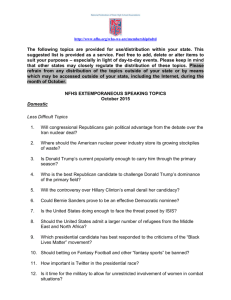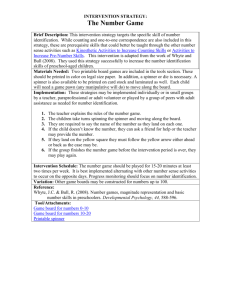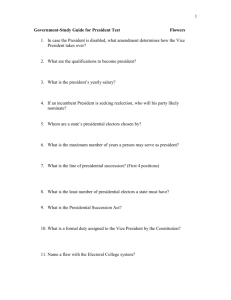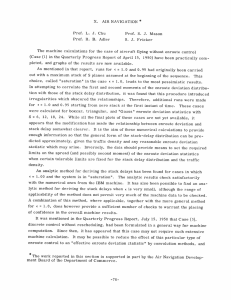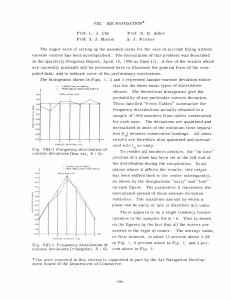Practice Final Exam Solutions and Hints
advertisement
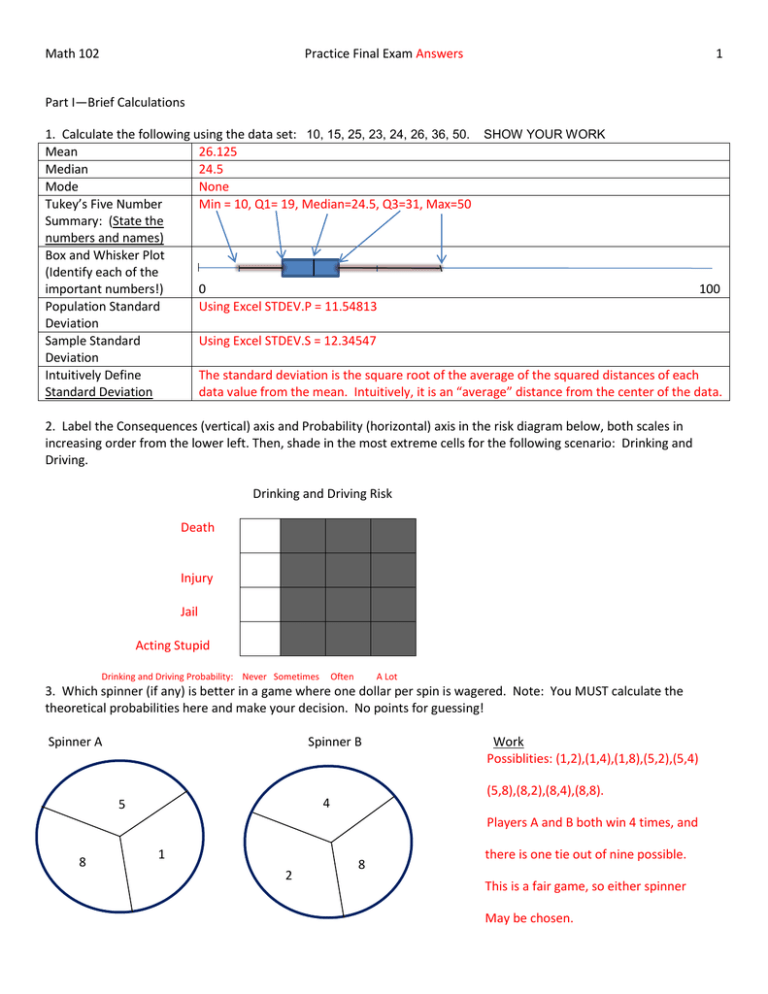
Math 102 Practice Final Exam Answers 1 Part I—Brief Calculations 1. Calculate the following using the data set: 10, 15, 25, 23, 24, 26, 36, 50. SHOW YOUR WORK Mean 26.125 Median 24.5 Mode None Tukey’s Five Number Min = 10, Q1= 19, Median=24.5, Q3=31, Max=50 Summary: (State the numbers and names) Box and Whisker Plot (Identify each of the important numbers!) 0 100 Population Standard Using Excel STDEV.P = 11.54813 Deviation Sample Standard Using Excel STDEV.S = 12.34547 Deviation Intuitively Define The standard deviation is the square root of the average of the squared distances of each Standard Deviation data value from the mean. Intuitively, it is an “average” distance from the center of the data. 2. Label the Consequences (vertical) axis and Probability (horizontal) axis in the risk diagram below, both scales in increasing order from the lower left. Then, shade in the most extreme cells for the following scenario: Drinking and Driving. Drinking and Driving Risk Death Injury Jail Acting Stupid Drinking and Driving Probability: Never Sometimes Often A Lot 3. Which spinner (if any) is better in a game where one dollar per spin is wagered. Note: You MUST calculate the theoretical probabilities here and make your decision. No points for guessing! Spinner A Spinner B (5,8),(8,2),(8,4),(8,8). 4 5 Work Possiblities: (1,2),(1,4),(1,8),(5,2),(5,4) Players A and B both win 4 times, and 8 1 2 8 there is one tie out of nine possible. This is a fair game, so either spinner May be chosen. Math 102 Practice Final Exam Answers 2 Part II. Use MS Excel to determine solutions to the following. Then copy the stated parts on this paper. 1. Are the scores on the data sheet for this problem normally distributed? Past histogram chart here Frequency Past Results of the 68-95-99% Rule: 12 Intervals 10 Min 68% 70.64588 95% 69.06176 99% 67.47764 Max Actual % of Scores 73.81412 57 75.39824 100 76.98236 100 8 6 4 2 0 71 The data are NOT normally distributed. The 68-95-99% rule fails and the histogram is neither centrally lumped nor symmetrically skewed. 2. Researchers in a national study determined that 74% of young people, ages 18-29 talk on handheld telephones while driving. In a class of 32 students at CWU, 23 said they do the same. Is the sample statistically like the population within a 95% confidence interval? SD = √𝑛𝑝(1 − 𝑝) =SQRT(32*(.74)*(1-.74)) = 2.48 .74*32 = 23.68 3. A random sample of voters from Math 311 indicated the voting choices shown in the data set. Based on 95% certainty, is choice of a gubernatorial candidate dependent on choice of a presidential candidate or not? 72 73 74 More Show your Confidence Interval (23.68-1.96*2.48, 23.68+1.96*2.48) = (18.8, 28.5) State your Decision The students at CWU are NOT significantly different from the US population, because 23 is in the 95% confidence interval above with the average for the US. State your Chi-square value Chi-square = 18. 6 Paste your 3-D Plot of Observed Values State p-value P = .0000165 which is much smaller than .05. Presidential Choice vs Gubernatorial Choice 16 20 10 1 6 0 O R I M Gubernatorial Choice Count Presidential Choice State your conclusion, based on comparing p with 5% Reject Ho; Choice of presidential candidate is significantly dependent on (or associated with) choice of gupernatorial candidate (or vice versa. Math 102 Practice Final Exam Answers 4. Suppose your probability of winning game is 1/3, and every Show your calculation here time you win, you get $3. How much should you pay out if you lose, so that the game is fair? 1/3*$3 = 2/3*X. Solve for X. 3 X = $1.50. In other words, you should pay $1.50 when you lose, which is twice as probable as winning, but when you win, you make twice as much as you lose! That’s what makes this game fair in the long run. 5. Suppose you take a road trip east from Ellensburg, setting your trip meter to 0 at the beginning of the trip. Then at various times, you note the mileage traveled and the time of travel. (See data sheet.) What can you state about your average rate of speed by way of linear regression. Regression Equation y = 57.89x - 10.99 Average speed 57.89 miles per hour Paste Regression Chart Accuracy of the Model Time Enroute vs Distance Traveled R² = 0.9996 400 y = 57.89x - 10.988 R² = 0.9957 300 Distance 200 Traveled (miles) 100 305 195 132 88 0 38 0 0 -100 265 1 2 3 4 Time Enroute (hours) 5 6
